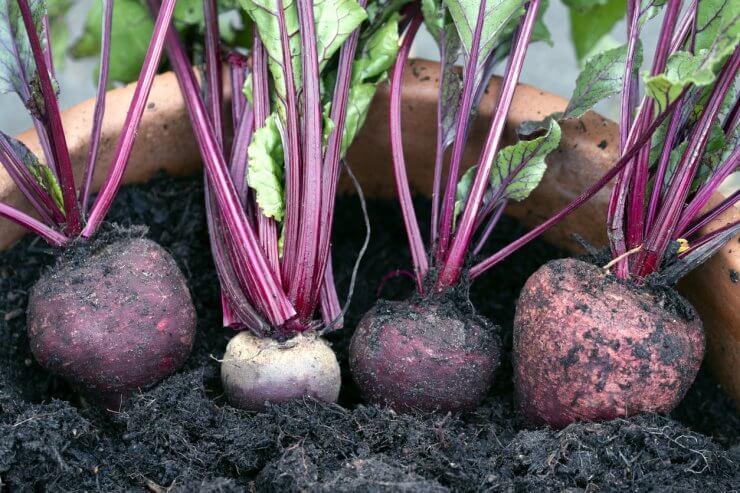
Beetroot picked from their planter
What gardeners in the U.S. call beets, the rest of the gardening world calls beetroot. This distinguishes the usually deep red beetroots that we eat from the bigger, longer white sugar beet that is grown to produce sugar.
Beetroot and sugar beet come from the same family, but they’re nutritionally different. We’re focusing on the beets that you can grow in your own garden for salads, side dishes, pickles, and more.
Beetroots are classified as Beta vulgaris. They’re part of the Goosefoot family (Chenopodiaceae), and actually come in more colors than the deep red you’re probably most familiar with.
Beetroots can be red, yellow, white, or even striped! The Chioggia beet has concentric pink and white stripes on the inside. There are also some varieties of white beet that are considered table beets like their more colorful cousins. These include the cultivars Avalanche and Albino. While most white beets are sugar beets, these are not—although they are sweet, and you could make sugar from them if you really want to. But in general they’re great for cooking and canning.
Here’s an overview of the types of beets common among home gardeners:
Common beets
These are the red beets with which we are most familiar. Deep red roots, large green leaves laced with red. Both leaves and roots are delicious. Some beets are red; others are more on the purple side.
Yellow beets
Yellow beets have excellent, rich flavor, from roots to leaves. A key benefit of yellow beets is that they don’t bleed or stain like red beets. Flesh color will range from yellow to golden orange.
Albino beets
Albino beets are white, and form round, sweet roots. Originally from Holland, Albino beets are a good choice for container gardening.
Striped beets
Also called Chioggia or Bassano beets, these beets sport concentric, target-like stripes of white and pink when you cut them open. Striped beets are on the sweeter side.
Mangel-Wurzel beets
These beets are also known as the Mangold beet and were once grown only to use as animal feed. They’re a little odd looking, shaped something like a cross between a carrot and a beet. These top-heavy roots can grow up to 20 pounds! They have a sweet flavor and the flesh ranges from white to golden yellow.
Formanova beets
These beets grow in a long, cylindrical shape, much like carrots. You need deep, uninterrupted soil to grow this type of beet.
You’ll find plenty of variety of beet seeds available at seed companies and garden centers. Ask your local extension center which type of beet is best suited for your gardening needs.
Which type of beets have you grown? Do you have a preference? Please share your opinion.


 Previous
Previous


Super beets info
Any beets that can grow in partial shade?